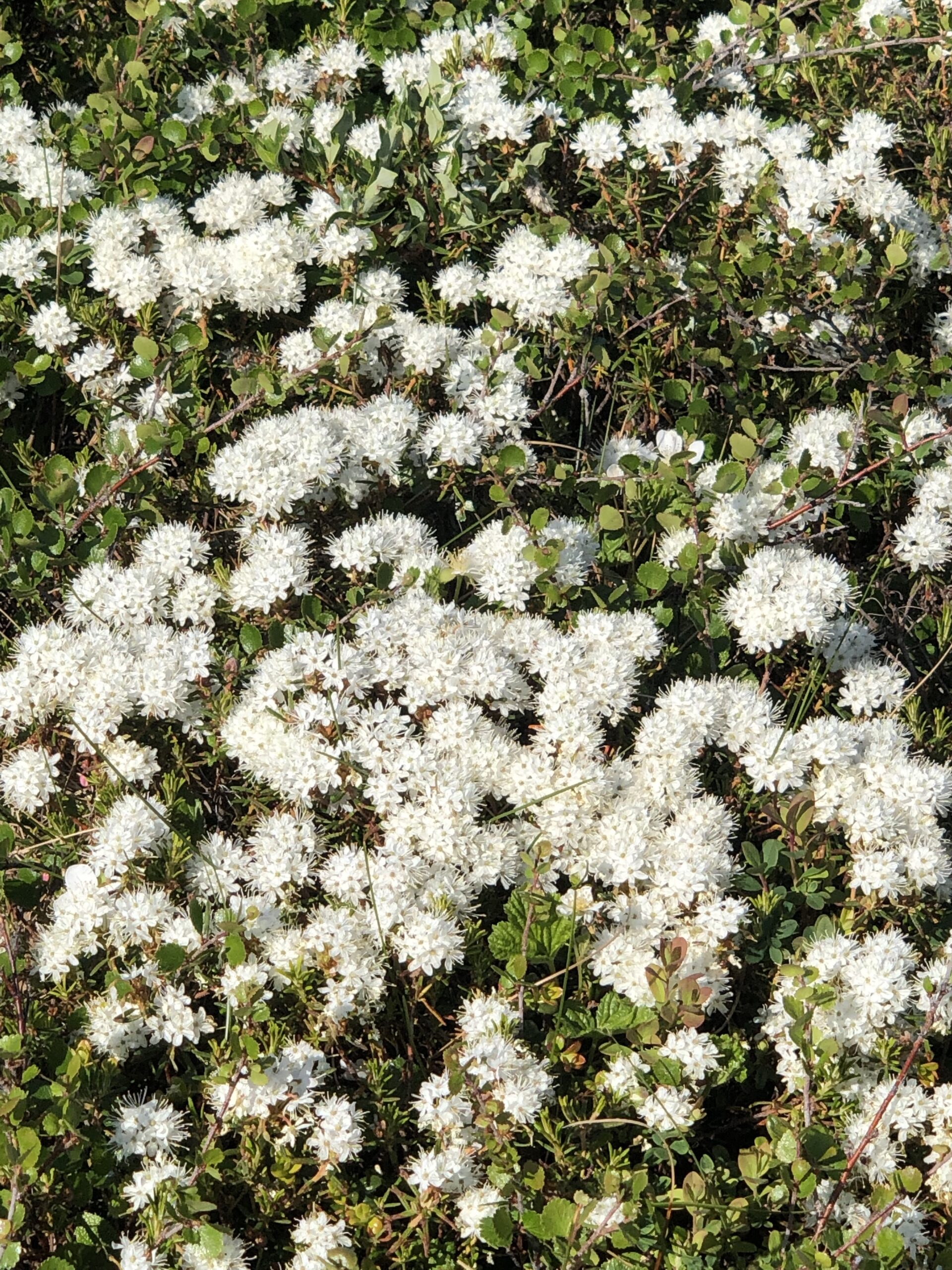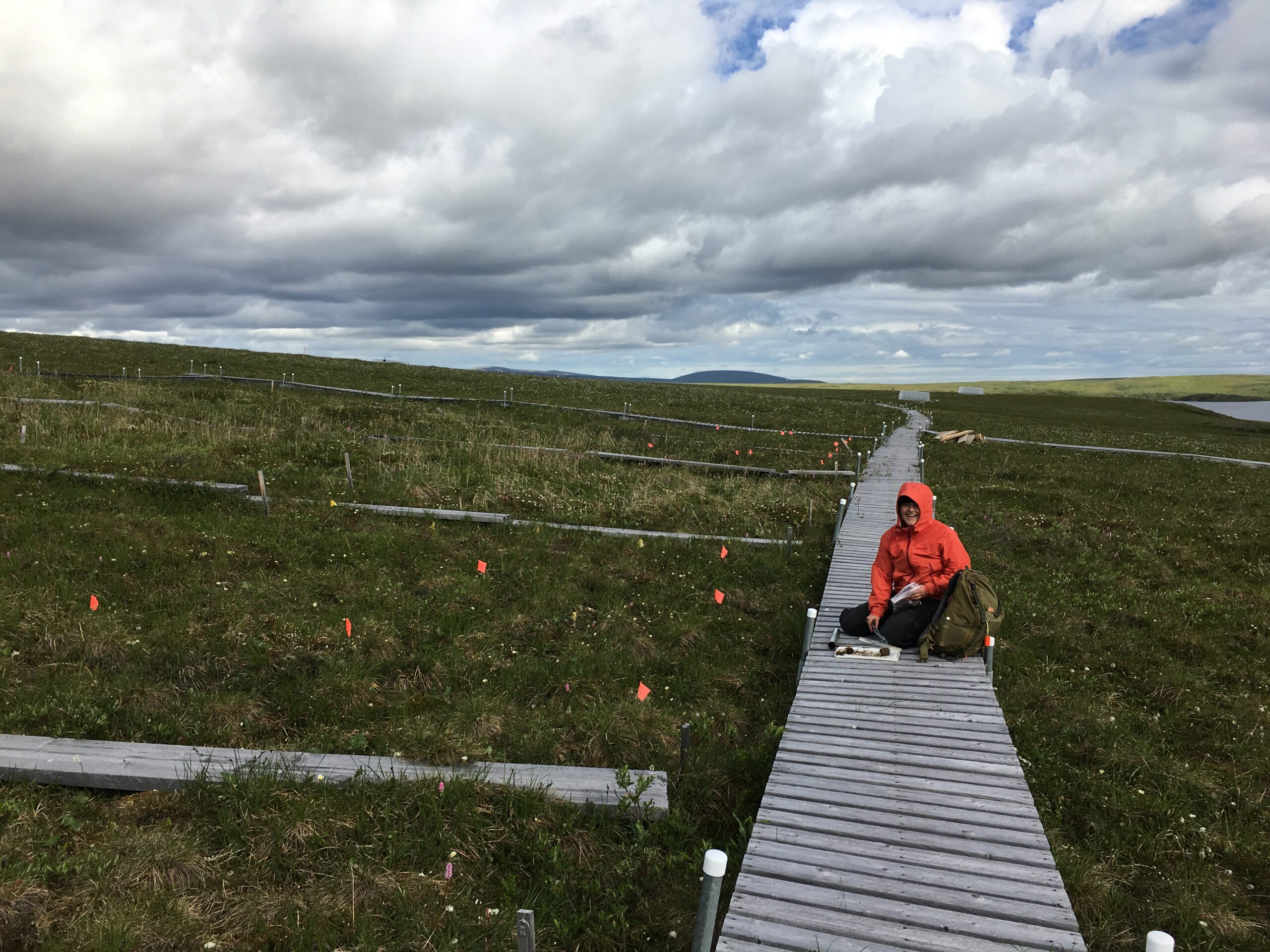Scientists at the Arctic LTER find that different points along a gradient of soil fertility aid ectomycorrhizal and ericaceous tundra shrubs. Their findings hint at the potential for those two types of shrubs to co-expand over the Arctic—a previously unconsidered scenario that could have vast implications for the future of the northern tundra
By: Nicholas T. Link, PhD Student at Northern Arizona University and Bonanza Creek LTER
The Changing Face of the Arctic
When you picture the Arctic tundra, images of a harsh, frozen, and unforgiving landscape come to mind. It’s easy to forget that the summer months are lush, green, and quite pleasant (if not for the clouds of mosquitoes).
Haley Dunleavy fell in love with the unique beauty of that wild land north of the treeline during her PhD at the Arctic LTER (ARC). “Without having those trees on the land, you lose sense of scale, and everything seems really close and really far away at the same time,” Dunleavy said.
While this landscape might initially appear to be pristine and untouched by humans, anthropogenic climate warming is occurring faster at high northern latitudes than almost anywhere else on earth. “The Arctic tundra is changing incredibly rapidly,” Dunleavy said. “Warming stimulates microbial activity in the soils,” which frees up stocks of “carbon and nitrogen that’s been frozen and locked up for years.”
The release of those soil nutrients from thawing permafrost may lead to shifts in vegetation cover, which affects local albedo and soil nutrient dynamics, both of which have broader implications for the global carbon cycle.
Dunleavy and her PhD advisor and co-author Michelle Mack sought to understand how different levels of increasing soil fertility may facilitate a shift in vegetation cover. To do so, they focused on two dominant tundra shrub species and their wildly different root associated fungi, called mycorrhizae, which have contrasting approaches to securing soil nutrients.
Their findings, recently published in Ecosphere, show that a range of fertilization has variable impacts on both the above and belowground components of the two species—which in turn may have major implications in this northern biome.

Rising Fertility Doesn’t Lift All Shrubs
For nearly a century, scientists in the Arctic were bold enough to ask the question: Do plants like being fertilized? And, believe it or not, the answer was: Yes, of course they do. “Plants love ammonium-nitrate,” Dunleavy said with a laugh.
A more nuanced finding from those fertilization experiments was that nutrient rich environments allowed Betula nana (dwarf birch)—an ectomycorrhizal species—to dominate its main shrub competitor, Rhododendron tomentosum (Labrador tea).

Credit: Haley Dunleavy, CC BY-SA 4.0.
The effect of fertilization on this shrub competition can be explained by the different skill sets of both species’ mycorrhizae. While Labrador tea’s mycorrhizal partners aren’t as good at grabbing all the easy nutrients, they are much better at unlocking the hard-to-get stuff already present in the soil. Dunleavy explained that we currently understand Labrador tea’s mycorrhizae to be “more enzymatically equipped” than dwarf birch’s, helping it to compete in less perfect conditions. That said, Dunleavy highlighted the massive gap in research on the mycorrhizae of ericaceous plants like Labrador tea. “There’s been very little work on ericoid mycorrhizae compared to other mycorrhizal types,” she said. “Once you open your eyes to ericaceous plants, and the potential for ericoid mycorrhizae to be acting, you see it everywhere—it seems silly to continue to ignore them!”
The contrasting nutrient acquisition approaches in the two main Arctic shrub species, and the surprising lack of focus on one species all together, interested Dunleavy because “soils themselves are really heterogeneous.”
The irregular distribution of soil textures, moisture regimes, and nutrients means that the level of fertilization across the Arctic with climate warming will be quite variable. Some spots will experience a moderate increase in soil nutrients while others will be completely saturated. Researchers weren’t really sure how that would impact either shrub species.
To address that gap, Dunleavy and Mack gathered data from a long-term fertilization gradient experiment at ARC. Established in 2006, the experimental site is fertilized at six different levels with both nitrogen and phosphorus and is part of a larger series of whole-ecosystem manipulation treatments.

Credit: Haley Dunleavy, CC BY-SA 4.0.
What they found was that at intermediate levels of fertilization, the height and extent of both dwarf birch and Labrador tea grew. However, with higher levels of fertilization the two species began to diverge. Dwarf birch continued to grow and expand while Labrador tea found itself on the losing side of the competition.
The story below ground also had some interesting surprises. Root enzyme activity for dwarf birch was not very responsive to fertilization, whereas Labrador tea’s dropped almost immediately with nutrient additions. Dunleavy said that this means that any level of fertilization “may result in a tundra where [Labrador tea’s] mycorrhizae are playing less of a role than [dwarf birch’s].” The transition from an enzymatic toolkit that can mine hard-to-get nutrients to one that can’t will likely have a pronounced impact on tundra nutrient dynamics in the future.

Credit: Sedona Spann, CC BY-SA 4.0.
What’s Shrubs Got To Do With It?
So, what happens if the tundra becomes shrubbier? And what if one species dominates?
As noted before, both Labrador tea and dwarf birch influence the tundra through a variety of physical and biogeochemical pathways. Each species has a different enzymatic toolkit, which leaves a distinct signature on nutrient cycling in the system.
Dunleavy went on to point out that tall shrubs like dwarf birch “collect snow over the wintertime and create this warm, insulative blanket over the soil” in a way that shorter and less sturdy shrubs like Labrador tea don’t.
Another difference, litter. Dwarf birch is a deciduous shrub that adds much more litter, or the sticks, leaves, and stems that fall off the plant, to the ecosystem than the evergreen Labrador tea. The quality of that litter is also varied, with birch litter being more available to consumers.
Given how these two species differ in their impact on belowground nutrient dynamics, snowpack, and litter inputs, any alterations to the coverage of either shrub “presents this huge pathway of changing tundra,” said Dunleavy.
In discussing her work, Dunleavy noted the value and need for long-term studies like this one to be able to tackle big and complicated questions. Long-term studies “not only allow us to explore questions of environmental change but allow us to explore some of these fundamental [questions] of ecology,” she highlighted. Her PhD advisor and co-author on this paper, Michelle Mack, concurred. Mack went further to emphasize that Arctic shrub expansion is an ideal testbed for studying how the response of plant growth to climate warming can have consequences for the global carbon cycle.
“We know that large areas of Arctic tundra are greening,” Mack said, referring to satellite observations of increasing aboveground plant productivity. By better understanding how shrub species and their mycorrhizae impact long-term decomposition and nutrient cycling, this study, and future research from the Mack group, will “shed light on the belowground processes that drive greening and ultimately determine the fate of Arctic carbon.”











